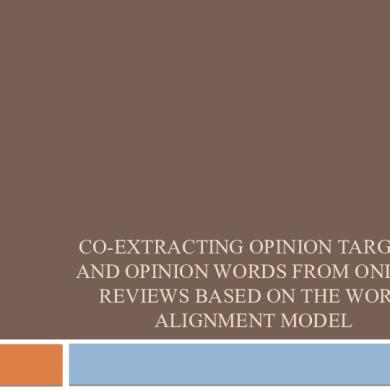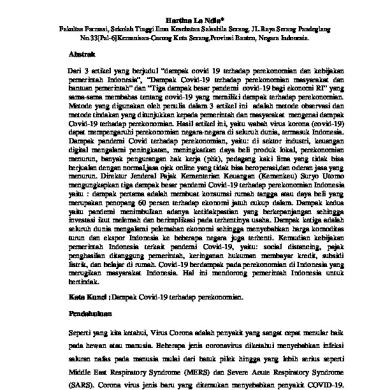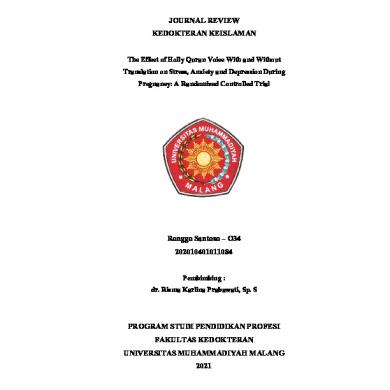* The preview only shows a few pages of manuals at random. You can get the complete content by filling out the form below.
Description
CO-EXTRACTING OPINION TARGETS AND OPINION WORDS FROM ONLINE REVIEWS BASED ON THE WORD ALIGNMENT MODEL
ABSTRACT:
Compared to previous methods based on the nearest-neighbor rules, our model captures opinion relations more precisely, especially for long-span relations. Compared to syntax-based methods, our word alignment model effectively alleviates the negative effects of parsing errors when dealing with informal online texts.
EXISTING SYSTEM:
In previous methods, mining the opinion relations between opinion targets and opinion words was the key to collective extraction. To this end, the most adopted techniques have been nearest-neighbor rules and syntactic patterns. Nearest neighbor rules regard the nearest adjective/verb to a noun/noun phrase in a limited window as its modifier. Syntactic information, in which the opinion relations among words are decided according to their dependency relations in the parsing tree.
DISADVANTAGES OF EXISTING SYSTEM:
Nearest neighbor rules strategy cannot obtain precise results because there exist long-span modified relations and diverse opinion expressions. Syntactic patterns are prone to errors. Online reviews usually have informal writing styles, including grammatical errors, typographical errors, and punctuation errors. This makes the existing parsing tools, which are usually trained on formal texts such as news reports, prone to generating errors. The collective extraction adopted by most previous methods was usually based on a bootstrapping framework, which has the problem of error propagation
PROPOSED SYSTEM:
To precisely mine the opinion relations among words, we propose a method based on a monolingual word alignment model (WAM). An opinion target can find its corresponding modifier through word alignment. We further notice that standard word alignment models are often trained in a completely unsupervised manner, which results in alignment quality that may be unsatisfactory.
ADVANTAGES OF PROPOSED SYSTEM:
Compared to previous nearest-neighbor rules, the WAM does not constrain identifying modified relations to a limited window; therefore, it can capture more complex relations, such as long-span modified relations. Compared to syntactic patterns, the WAM is more robust because it does not need to parse informal texts. In addition, the WAM can integrate several intuitive factors, such as word co-occurrence frequencies and word positions, into a unified model for indicating the opinion relations among words. Thus, we expect to obtain more precise results on opinion relation identification.
SYSTEM ARCHITECTURE:
Query
standard retrieval & ranking scheme -tf*idf -language model -probabilistic
STAGE 2
Ranked opinionated documents
Ranked documents
opinion related re-ranking/filter -dictionary based -text classification -linguistics
STAGE 1
HARDWARE REQUIREMENTS:
System Hard Disk Floppy Drive Monitor Mouse Ram
: Pentium IV 2.4 GHz. : 40 GB. : 1.44 Mb. : 15 VGA Colour. : Logitech. : 512 Mb.
SOFTWARE REQUIREMENTS:
Operating system : Windows XP/7. Coding Language : JAVA/J2EE IDE : Netbeans 7.4 Database : MYSQL
MODULES:
Online Shopping Module Co-Extraction of Opinion Targets User Rating Module Data Collection Module Graph Rating Detection Positive and Negative Ratings
Online shopping Module
In the module, we developed a website for online shopping. The user can purchase products and also has the facility to provide ratings and their suggestions as feedback. In this module, the admin can add product details (product name, price, validity etc..) based on the category likes mobiles, computers, laptops etc., and maintain the product details. The user enter their credit card details, the credit card is validated. If the card details is valid, the user can purchase their items. The user can select purchasing products displayed in the home page or search the product using keyword or based on category. Then user can purchase the product using credit/debit card. To purchase, the user need to provide the following details like (credit card number, card holder name, date of birth, credit card provider). If the credit card is valid the user is allowed to purchase the product.
Co-Extraction of Opinion Targets:
In this module, we develop the system such that To extract and analyze opinions from online reviews, it is unsatisfactory to merely obtain the overall sentiment about a product. In most cases, customers expect to find fine-grained sentiments about an aspect or feature of a product that is reviewed. Readers expect to know that the reviewer expresses a positive opinion of the phone’s screen and a negative opinion of the screen’s resolution, not just the reviewer’s overall sentiment.
User Rating Module
In this module, the user is allowed to have the facility of providing their feedback in form of ratings regarding the service provider. User ratings are considered as one of the important factor as they play a vital role in the purchase of the product. Wrong/unfair ratings may lead to severe problems in many systems. So in this module, we collect the user ratings and secure them.
Data Collection Module
In this module, the entire user profiles value and ratings are collected. User profiles values also include their time, duration and rating values etc. All the user profiles including ratings values are saved securely.
Graph Rating Detection Module
In this module, all the data’s collected are used as a dataset. In the Dataset, we identify the Positive and Negative user ratings by number of feedbacks provided. The graph displays the user’s feedback across positive and negative terminals with overall total ratings as well.
Positive and Negative Ratings:
In this module, we develop the system such that user of the portal can have the rights to provide the positive and negative ratings to the product which he/she buys, such that the admin can view the list of ratings.
REFERENCE:
Kang Liu, Liheng Xu, and Jun Zhao, “CoExtracting Opinion Targets and Opinion Words from Online Reviews Based on the Word Alignment Model”, IEEE TRANSACTIONS ON KNOWLEDGE AND DATA ENGINEERING, VOL. 27, NO. 3, MARCH 2015.













